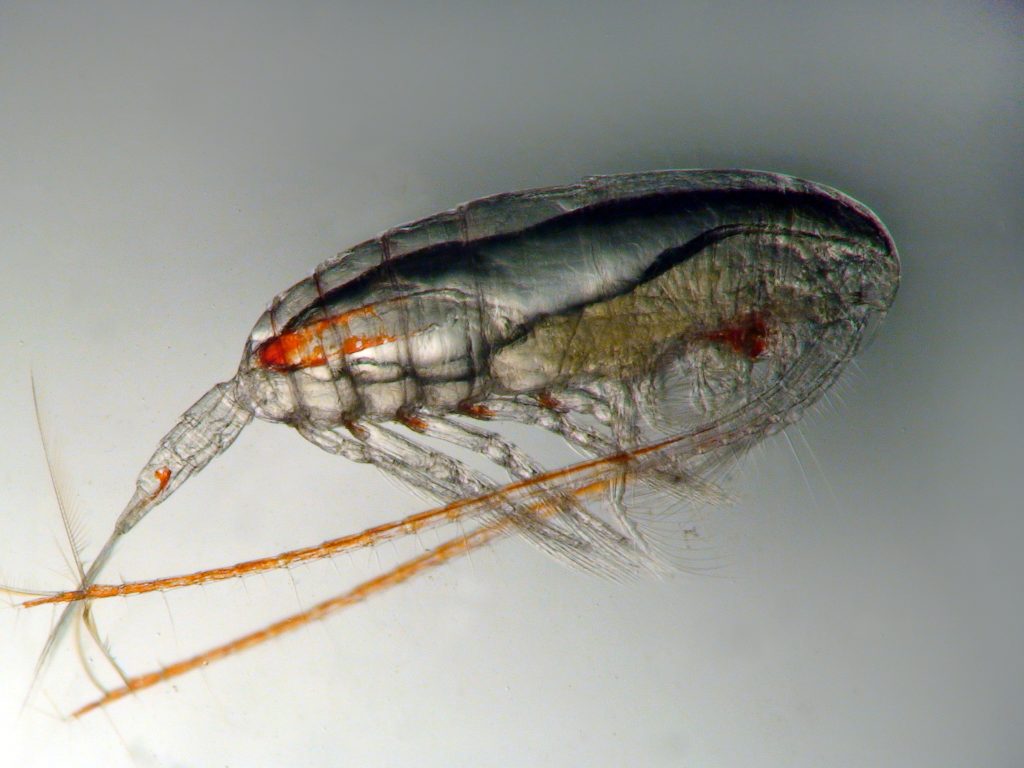For this month, the FEZ blog is starring a group of tiny, yet particularly important marine animals. Calanoid copepods of the genus Calanus (raudåte på norsk) are present in all seas of our planet but it is in the northern hemisphere that these little crustaceans are the most abundant. They may be small, 2-3 mm long, but they are many! They form immense patches in the sea that are visible from space! When you go bathing in the sea along the Norwegian coast, in Spring or early Summer, they are all around you, look closely and you will start noticing how numerous they are. You can usually spot them because of their red pigmentation, in particular in their antennae. This pigmentation protects them from harmful UV light, and Calanus can adjust its level within hours. Hence, some of them appear completely pale, while others are radiant red.

In the North Atlantic and Arctic Oceans, Calanus dominate the zooplankton biomass. Different species of Calanus exist and each one is particularly associated to a specific environment. In the Norwegian Sea, Calanus finmarchicus is the most abundant, although the Arctic C. glacialis and C. hyperboreus have recently been identified in several Norwegian fjords.
Ecologically essential
Calanus are keystone species. They feed on phytoplankton and are the main food source for various organisms including invertebrates, marine birds, marine mammals and fish. Cods, mackerels, herrings all rely on Calanus during their larval development, making Calanus crucial in sustaining entire fisheries. What makes them such an attractive food source is their high content in energy-rich lipids, which they synthesise and store in their oil sac. This allows them to survive during their winter hibernation at depth, when there is no phytoplankton around for Calanus to feed on. In early Spring, they re-emerge, perfectly timed to feed on the blooming phytoplankton.
Commercially important
Beyond their ecological role, the nutritional value of Calanus has attracted the attention from commercial companies. Since the early 2000s, Calanus finmarchicus has been harvested, with Norway setting a quota of 254,000 tones per year in 2020, a target yet to be reached by fisheries. This valuable resource serves a dual purpose: as a growing component in aquaculture feed, and for Calanus oil extraction. The extracted oil is used to produce pills for human consumption, with reported benefits on symptoms related to obesity and type II diabetes.
Beacons of climate change
Calanus are very sensitive to changes in their environment and are among the first organisms of the planet to respond to environmental variations by shifting the distribution of their populations. A notable example occurred in the 1980s, when a slight increase in seawater temperature triggered a shift of C. finmarchicus away from the North Sea, which resulted in a near-collapse of the local cod stocks. This is why biologists often use the changes in Calanus species distribution ranges as early indicators of climate change.
Uncertain fate under climate change
Calanus are considered particularly successful organisms. They have been around for millions of years, have colonised all types of marine habitats and are the most numerous organisms on Earth. While Calanus have withstood a number of climatic crises, the question of whether they will be able to endure the unprecedented pace of today’s climate change remains open.
This is why I am studying their DNA, aiming to determine whether Calanus are equipped with the right genes that may allow them to adapt to rapid changes in their environment. However, this task presents a formidable challenge, given that the complete set of Calanus DNA, their genome, is not just vast—it’s 2 to 4 times larger than the Human genome. The sheer magnitude of their genetic code makes its exploration a daunting feat with current technologies. Unraveling the secrets hidden within the expansive DNA of Calanus species requires a blend of creativity, innovative strategies, and the cutting edge of technological advancements.
![]()
